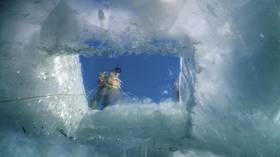Russia’s long-endurance Arctic drone sub to swim 10,000km under ice during trials

A secret Russian drone designed for long patrols of its Arctic waters will be ready for the first phase of sea trials in 2021, a top defense research official said. The non-nuclear sub is meant to stay underwater up to 3 months.
The Sarma project, which is overseen by Russia’s state-owned Foundation for Advanced Research, was first confirmed to be in the works in 2018. Little is known about the future drone, except that it has been touted as an element of security for the Northern Sea Route – the 14,000km long maritime connection between northern Europe and the Pacific along Russia’s Arctic coast.
Also on rt.com China building its first nuclear-powered icebreaker to enter the ArcticIgor Denisov, the deputy head of the foundation responsible for physical and technical research, reported that the construction of the first demonstrator for the Sarma project will start in July this year while the first sea trials of the drone are planned in the White Sea in 2021.
“The benchmark experiment will require the vehicle to swim 10,000km without surfacing and without nuclear propulsion. That translates into about three months of endurance,” the official told RIA Novosti in an interview, adding that the drone will be modular.
Last year Denisov said that the initial trial of the advanced watercraft would be conducted in the Black Sea and involve a 2,000km swim. A total of three demonstrators were planned with the Arctic phase of sea trials scheduled for 2022-2023.
Sarma is remarkable because unlike Poseidon, the gigantic strategic nuclear-armed drone currently being developed in Russia, it will not have a nuclear reactor – a time-tried technology perfect for long-endurance submarines. Some sort of air-independent propulsion (AIP) will be used, according to Viktor Litvinenko, project leader at the Lazurit Central Design Bureau, the submarine designer company responsible for creating Sarma.
A regular submarine needs to surface every few days to start onboard diesel generators and recharge its electric batteries, which in turn provide power when submerged. This makes the vehicle vulnerable to detection and possible attack. AIP systems address this by either carrying a supply of oxidant for the diesel or using a less oxygen-hungry type of technology for producing electricity.
Notably, Russia is not confirmed to have an operational AIP submarine. The sole candidate for incorporating this technology is the Lada-class diesel-electric submarine Sankt Peterburg, a leader of its class, which may have a fuel cell-based air-independent power plant.
The propulsion system for Sarma may prove to be more efficient and safe for the environment than a comparable nuclear reactor, according to the designer, but it remains unknown which type of AIP it will be. Some speculation last year indicated that the first demonstrator probably won’t have one at all and use regular electric batteries to test other systems. The final variant may have either a Stirling-cycle engine or hydrogen power cells.
Despite its role in providing security, Sarma apparently will be unarmed and used for missions like traffic monitoring, mapping and seismic research.
If you like this story, share it with a friend!













